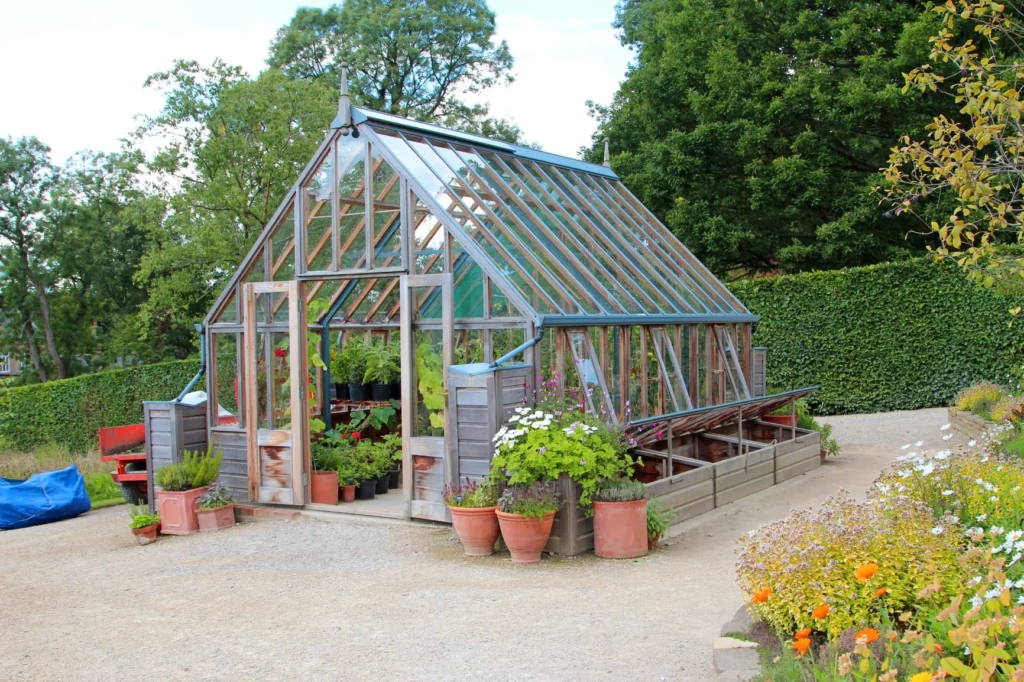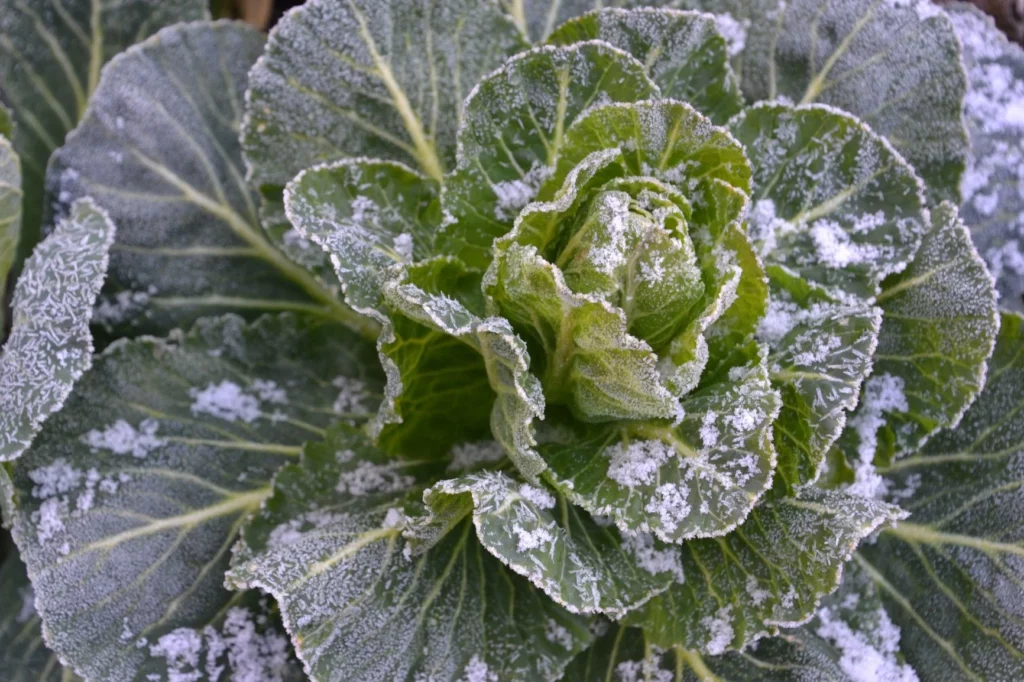What, you can garden even in winter? It’s hard to believe, but even in the cold season you can plant and harvest some vegetables. Especially if you want to provide for yourself, it is recommended to use the winter for your vegetable gardening. In this article you will learn which varieties you can grow and what you need to bear in mind in the open, on the balcony or raised bed in winter.
Slow growing winter vegetables (approx. 100 days):
- Brussels sprouts, Chinese cabbage, savoy cabbage, Jerusalem artichokes, beet, parsnips and salsify.
- Sowing: April – June
Medium-fast growing winter vegetables (about 55-70 days):
- Butter cabbage, green cabbage, Chinese cabbage, and sugarloaf.
- sowing: July – August
fast-growing winter vegetables (about 40-50 days):
- Spinach, lamb’s lettuce, winter purslane, winter cress or chard.
- Sowing: September – October
Fall-planted vegetables that can be harvested in the spring:
- Field bean, onions or garlic.
- Staking/sowing: September, early October
- Winter cultivation: The right time to sow
Some hardy vegetables need enough time to grow large enough to handle the first frosts. These slow-growing varieties include many cabbage varieties such as Brussels sprouts, Chinese cabbage and savoy cabbage. Root vegetables such as Jerusalem artichokes, beets, parsnips and salsify also need adequate time (about 100 days) to grow.
Medium-speed vegetables include butter, Chinese, and kale, as well as sugarloaf. They need an average of 55 – 70 days for their development.
The fast vegetables, on the other hand, take only 40 – 50 days on average to grow large enough to endure the first frosts. Among them are spinach, lamb’s lettuce, winter purslane, winter cress or chard. You can still sow these in September, some even until October.
Some crops begin to sprout when you plant them late in the year. They stop growing as soon as the first frosts begin and then continue to grow in the spring. This gives them a head start on spring-sown crops and allows them to be harvested very early. This is the case, for example, with some varieties of field beans. Winter onions or garlic can also be planted in late spring and harvested accordingly early in the year.

Contents
Winter cultivation: these options are available
Protected cultivation
Protected cultivation means nothing other than that you want to “protect” your crops from environmental influences such as cold. You can do this, for example, by using foil tunnels, fleece or a greenhouse. This allows you to extend the harvest season, so you can still harvest in winter. Crops such as tomatoes are produced in Central Europe almost exclusively in protected cultivation. Outdoors, the risk of disease would be far too great, so they are grown year-round in greenhouses.
Open ground with frost-hardy varieties
A few crops can also be grown outdoors in winter. Some frost-hardy varieties can withstand the cold or become flavorful only when exposed to low temperatures. This is mainly due to the starch in the plants, which is converted into sugar by cold temperatures. Outdoors, you can further protect your plants by adding a layer of mulch. Cabbages, root vegetables and winter lettuces are well-known representatives of winter vegetables. You can find out which varieties are suitable for outdoor cultivation in winter below.
Live storage in the field
Some vegetables can be left in the field even though it is getting cold. This does not harm these vegetables, but keeps them nice and fresh over the winter. This way your garden can provide you with important vitamins and nutrients even when it’s cold.

What vegetables can I grow outdoors in winter?
Winter purslane
Purslane can be sown in the field from September to February. After about 8 weeks, it can be harvested until spring. Purslane tastes delicious in salads, stir-fries or soups and provides important minerals at the same time.
Lamb’s lettuce
Winter lettuce is probably one of the best-known winter crops that can still be sown into October. Here too, depending on the weather, it can be harvested until spring. Here a mixed culture with cabbage or winter purslane offers itself.
Winter cress
This cress variety can be sown even in September. About 8 – 12 weeks later, you can harvest the feathery leaves, as well as the flowers. The frost-hardy plant can also be grown in the field until late in the winter. Winter cress tastes especially good in salads or on bread.
Swiss chard
This colorful classic is quite frost-resistant and can therefore be harvested well into Christmas or even into the new year. Winter-hardy varieties can be sown as late as November. Protect the chard with a mulch layer of straw or a fleece. This will ensure the leafy vegetable’s survival even on very cold nights.
Garlic and winter onions
Both can be stuck in the fall (early October) so that they can be harvested the next year. Winter onions are ready for harvest from May, and garlic can be harvested in July.
Field bean
You can sow this type of bean as early as autumn (September), so that it already begins to sprout. Since no stems are formed at the beginning, the broad bean can tolerate temperatures as low as – 8 °C. At the beginning of spring, the plant will continue to grow and produce early harvests. The field can then be used for another crop that benefits from the nitrogen-enriching effect of the legume. Tomatoes or celery, for example, are suitable for this.
Spinach
Spinach can also be sown until the beginning of October. It is then harvested from mid-November to early April. Choose robust, hardy varieties for this, such as ‘Andromeda F1’. In very cold nights, the spinach can be additionally covered with fleece or tearing.
Which vegetables can I overwinter in the field?
Leeks
If you choose a hardy variety, you can leave leeks all winter and harvest them fresh when needed. The onion plant copes well with frost and will keep for a long time in the field. Leeks are sown as early as April/May, which allows them to develop throughout the summer.
Salsify
Salsify is a vegetable that is quite trendy right now. It is also called winter asparagus because of its taste. Starting in April, the seeds of the root can be sown in grooves 2 cm deep. As soon as the foliage begins to yellow, it can be harvested. This is usually the case from mid-November. To avoid damaging the roots, dig a 30 cm deep trench close along the planting row and pull the roots out towards the trench. The black stalks can be peeled like asparagus. It is easier to pull off the peel if you boil them in salt water beforehand. The milky juice that comes out of the roots is sticky and causes dark discoloration on the hands. These can be removed again with lemon juice. Black salsify tastes great in stews, as a cream soup or as a side dish.
Jerusalem artichoke
This species of sunflower, native to North America, forms tuberous, brown-purple appendages at its root, which can be harvested. You can plant the tubers outdoors from mid-April. Make sure to plan enough distance to other vegetables, as the strong-growing plant likes to crowd out other crops. Over the summer, the plants grow up to three meters high. As soon as the upper part of the plant is dead, the roots can be harvested. From October to March, you can dig up root parts as needed, because the dug up parts can’t be stored for long.
Brussels sprouts
Brussels sprouts need to be sown as early as mid-May to give them enough time to develop. The small florets can then be harvested from November. As with kale, the more frost the cabbage can withstand, the milder its flavor.
Chinese cabbage
Sown at the end of July, this cabbage variety can even withstand temperatures of – 4 °C. Wrapped in garden fleece or brushwood, it can be harvested in mild climates until the end of November.

Savoy cabbage
The variety ‘Winter Prince 2’ can be sown from May to June. It is very cold tolerant and survives temperatures of -10 °C well. Depending on how early it was sown, the winter variety can be harvested as early as the end of October. However, harvesting of the robust cabbage is still possible until the new spring.
Kale
Kale is a very well-known winter vegetable. It only starts to taste really good at cooler temperatures. Pre-grown, the classic can be planted out from July to the end of August. The earlier it is planted, the more time it has to develop vigorously. It can finally be harvested from the first frosts in autumn. But it is worth waiting: the longer the cabbage is exposed to the frosts, the sweeter and milder its taste. For harvesting, you can cut off individual leaves of the crown.
Butter cabbage
Cabbage can also be sown until the end of July. By the first frosts it begins to form its cabbage head, which turns yellow to orange. From November you can start harvesting: Either take off individual leaves from the outside or cut off whole heads if necessary. From February, the butter cabbage begins to turn green again from the inside.
Parsnip
The root vegetable can be easily overwintered. Sowing is done in April in row distances of 40 cm. The roots remain in the soil and can be dug up from October until late winter if necessary. Only when the sub-zero temperatures persist, you should not touch the roots and wait until it thaws again. If this takes you too long, dig up all the parsnips and store them in a dark, dry, cool place (cellar). Choose a hardy variety for winter growing.
Sugarloaf
You can use the chicory plant like chicory or radicchio to make tasty and healthy winter salads. For this, sow with a planting distance of 30 cm until mid-July. The seeds should be about 2 cm deep in the soil. After 8 – 12 weeks you can harvest the sugar loaf. However, if you want to use it in winter as well, that’s no problem: the plant is very robust and can be harvested throughout the winter.
Growing winter vegetables on the balcony
If you want to cultivate winter vegetables on your balcony, you should insulate your pots and tubs really well. These cool down much faster than the garden soil, which is why often even the hardiest winter vegetables capitulate. This is because even if the plant can cope with frost on its own, it cannot absorb frozen soil water. As a result, it eventually dies of thirst during prolonged frosts. For insulation, you can add Styrofoam sheets around your containers or place them in jute bags filled with leaves. Coconut matting also works well as cold protection. Additionally, cover the soil of the container with fleece or brushwood. It is best to place your containers near the wall of the house, because there it is much more protected and warmer in winter than on the parapet of the balcony.
Winter vegetables suitable for the balcony:
Swiss chard, lamb’s lettuce, kale, butter cabbage, savoy cabbage, beet, spinach.
Raised bed in winter
In summer, raised beds have the advantage that they warm up much faster than normal soil due to their elevated position, but in autumn they also cool down faster. Therefore, you should provide adequate protection from the cold here as well:
Wrap the bed with garden fleece, bubble wrap or a coconut mat. This not only protects the material, but also the roots of the winter crops in the raised bed.
A mulch layer of straw or cuttings is suitable as a protective overlay layer. In addition, you can cover more sensitive crops with fleece or brushwood.
Raised beds can not only bring your gardening season forward in spring, but also extend it in late spring. They keep moisture and heat to the plants through the translucent plastic or glass.










